OM# Documentation
Loops
A loop is an iteration: a process that repeats an operation a number of times to perform repetitive tasks, accumulation, collection of data, etc. Loops are not the easiest thing to do in OM#, but they can become a powerful ally.
See also:
mapcaris a nice an also powerful alternative to the OM# loop feature in many cases. It is often a matter of style!
iterate
Loops in OM# are standard patches (with any number of inputs and outputs) including one or more iterate boxes.
Each iterate box accounts for a loop.
iterate evaluates its input(s) a number of time as determined by the loop iterators (loop-for, loop-list, loop-tail, loop-while) that are connected to it, either directly or indirectly. The example below prints the elements in a list:
The iterate box can have an arbitrary number of inputs, which are evaluated from left to right and allow for combining iterators and the sequencing of actions inside the loop.

iterate triggers evaluation, but does not return a value from the patch, as standard outputs / out boxes do.
The iterations therefore generally produce side-effects (print is one of them) or data collection (for instance using collect or accum, whose value can be returned by the patch outputs) (see below, data collection).
While editing a loop, it is possible to get a “preview” of the iteration result by evaluating the iterate box.
The list displayed in the listener here is however a display artifact, as iterate by itself does not collect any data.

Iterators: loop-for, loop-list, loop-tail, loop-while
There exist 4 different iterators:
loop-listiterates on the successive elements of a list
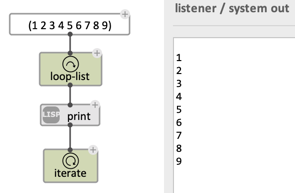
loop-tailiterates on the tail of a list, popping out the first element each time

loop-foriterates between two numbers
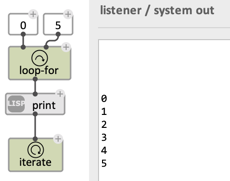
loop-whileiterates while a given condition is true
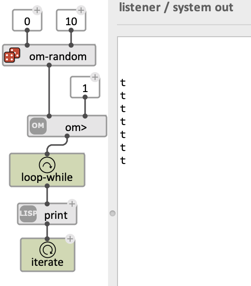
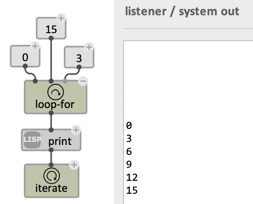
Optional inputs in iterators
Some iterators (
loop-for,loop-list,loop-tail) have an optional input calledby. This parameter controls the iteration with more advanced criteria.The meaning is somehow straightforward in the case of
loop-for: iterate from a to b by n (the default is 1).With
loop-listandloop-tail,byis a function determining how to get the next state of the list (the default iscdr: we just pop the first element out).
Combining iterators
Several iterators can be combined and connected to a same iterate box.
This is when loops start to be more expressive and powerful than usual map... iterators.
The iteration stops as soon as one of the iterator finishes:

This makes sense in particular for the loop-while iterator, which essentially works connected to other iterators.
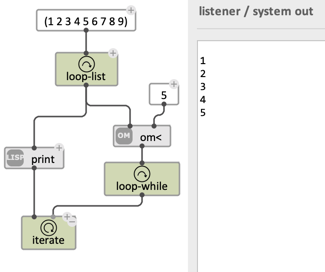
Note: Iterator values are not valid outside of the
iteratecontext. It is an error to connect it directly to a loop output, for instance. In order to return the last value of an iterator, use a memory box likememorcollect(see below).
Data collection
One of the main use of loops in OM# will be the iterative processing and collection of data.
collect (or accum, for more advanced use) are iterate’s best friends for that purpose.
- Connect the first output (:collect) of a
collectbox toiterate, in order to collect/accumulate data in memory. - Connect the second output (:data-out) of the
collectbox to an output to return the collected data at the end of the loop.

See also: Memory → More on
collect/accum
Summing Up…

When a patch containing an iterate box is evaluated, the following actions happen in order:
- Evaluation of the
init-doboxes (if any).init-dois a special box specifying actions to perform before iteration starts (for instance preparing initial states). - Iteration of the
iterateboxes - Evaluation of the
outboxes (just like in a standard patch)
Hint: Up to a certain level of complexity, the Lisp code visualization feature can be useful to understand what the loop-abstraction is doing.